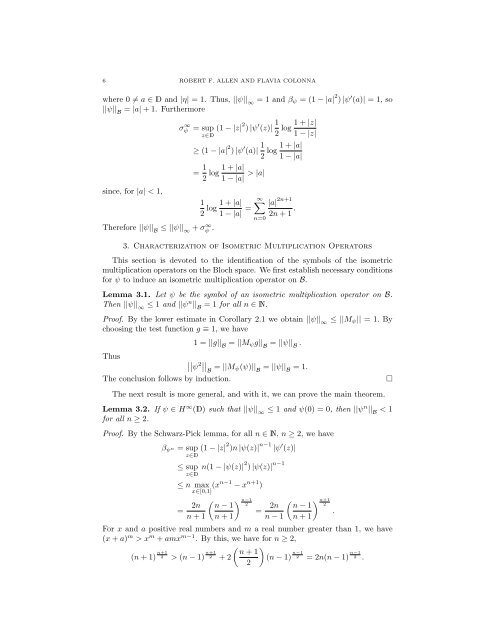Isometries and spectra of multiplication operators on the Bloch space
Isometries and spectra of multiplication operators on the Bloch space Isometries and spectra of multiplication operators on the Bloch space
6 ROBERT F. ALLEN AND FLAVIA COLONNA where 0 = a ∈ D
So ISOMETRIC MULTIPLICATION OPERATORS 7 2n n + 1 n−1 2 n − 1 = n + 1 2n(n − 1) n−1 2 (n + 1) n+1 2 < 1. Hence ||ψn || B = βψn < 1 for n ≥ 2. Corollary 3.1. If ψ is the symbol
- Page 1 and 2: ISOMETRIES AND SPECTRA OF MULTIPLIC
- Page 3 and 4: ISOMETRIC MULTIPLICATION OPERATORS
- Page 5: ISOMETRIC MULTIPLICATION OPERATORS
- Page 9 and 10: ISOMETRIC MULTIPLICATION OPERATORS
- Page 11: ISOMETRIC MULTIPLICATION OPERATORS
6 ROBERT F. ALLEN AND FLAVIA COLONNA<br />
where 0 = a ∈ D <str<strong>on</strong>g>and</str<strong>on</strong>g> |η| = 1. Thus, ||ψ|| ∞ = 1 <str<strong>on</strong>g>and</str<strong>on</strong>g> βψ = (1 − |a| 2 ) |ψ ′ (a)| = 1, so<br />
||ψ|| B = |a| + 1. Fur<strong>the</strong>rmore<br />
since, for |a| < 1,<br />
Therefore ||ψ|| B ≤ ||ψ|| ∞ + σ ∞ ψ .<br />
σ ∞ ψ = sup (1 − |z|<br />
z∈D<br />
2 ) |ψ ′ (z)| 1 1 + |z|<br />
log<br />
2 1 − |z|<br />
≥ (1 − |a| 2 ) |ψ ′ (a)| 1 1 + |a|<br />
log<br />
2 1 − |a|<br />
= 1 1 + |a|<br />
log > |a|<br />
2 1 − |a|<br />
1 1 + |a|<br />
log<br />
2 1 − |a| =<br />
∞<br />
n=0<br />
|a| 2n+1<br />
2n + 1 .<br />
3. Characterizati<strong>on</strong> <str<strong>on</strong>g>of</str<strong>on</strong>g> Isometric Multiplicati<strong>on</strong> Operators<br />
This secti<strong>on</strong> is devoted to <strong>the</strong> identificati<strong>on</strong> <str<strong>on</strong>g>of</str<strong>on</strong>g> <strong>the</strong> symbols <str<strong>on</strong>g>of</str<strong>on</strong>g> <strong>the</strong> isometric<br />
<str<strong>on</strong>g>multiplicati<strong>on</strong></str<strong>on</strong>g> <str<strong>on</strong>g>operators</str<strong>on</strong>g> <strong>on</strong> <strong>the</strong> <strong>Bloch</strong> <strong>space</strong>. We first establish necessary c<strong>on</strong>diti<strong>on</strong>s<br />
for ψ to induce an isometric <str<strong>on</strong>g>multiplicati<strong>on</strong></str<strong>on</strong>g> operator <strong>on</strong> B.<br />
Lemma 3.1. Let ψ be <strong>the</strong> symbol <str<strong>on</strong>g>of</str<strong>on</strong>g> an isometric <str<strong>on</strong>g>multiplicati<strong>on</strong></str<strong>on</strong>g> operator <strong>on</strong> B.<br />
Then ||ψ|| ∞ ≤ 1 <str<strong>on</strong>g>and</str<strong>on</strong>g> ||ψ n || B = 1 for all n ∈ N.<br />
Pro<str<strong>on</strong>g>of</str<strong>on</strong>g>. By <strong>the</strong> lower estimate in Corollary 2.1 we obtain ||ψ|| ∞ ≤ ||Mψ|| = 1. By<br />
choosing <strong>the</strong> test functi<strong>on</strong> g ≡ 1, we have<br />
Thus<br />
1 = ||g|| B = ||Mψg|| B = ||ψ|| B .<br />
<br />
ψ 2 B = ||Mψ(ψ)|| B = ||ψ|| B = 1.<br />
The c<strong>on</strong>clusi<strong>on</strong> follows by inducti<strong>on</strong>. <br />
The next result is more general, <str<strong>on</strong>g>and</str<strong>on</strong>g> with it, we can prove <strong>the</strong> main <strong>the</strong>orem.<br />
Lemma 3.2. If ψ ∈ H ∞ (D) such that ||ψ|| ∞ ≤ 1 <str<strong>on</strong>g>and</str<strong>on</strong>g> ψ(0) = 0, <strong>the</strong>n ||ψ n || B < 1<br />
for all n ≥ 2.<br />
Pro<str<strong>on</strong>g>of</str<strong>on</strong>g>. By <strong>the</strong> Schwarz-Pick lemma, for all n ∈ N, n ≥ 2, we have<br />
βψn = sup (1 − |z|<br />
z∈D<br />
2 )n |ψ(z)| n−1 |ψ ′ (z)|<br />
≤ sup n(1 − |ψ(z)|<br />
z∈D<br />
2 ) |ψ(z)| n−1<br />
≤ n max<br />
x∈[0,1] (xn−1 − x n+1 )<br />
= 2n<br />
n + 1<br />
n − 1<br />
n + 1<br />
n−1<br />
2<br />
= 2n<br />
n − 1<br />
n+1<br />
2 n − 1<br />
.<br />
n + 1<br />
For x <str<strong>on</strong>g>and</str<strong>on</strong>g> a positive real numbers <str<strong>on</strong>g>and</str<strong>on</strong>g> m a real number greater than 1, we have<br />
(x + a) m > xm + amxm−1 . By this, we have for n ≥ 2,<br />
<br />
n + 1<br />
(n + 1) n+1<br />
2 > (n − 1) n+1<br />
2 + 2<br />
2<br />
<br />
(n − 1) n−1<br />
2 = 2n(n − 1) n−1<br />
2 .



